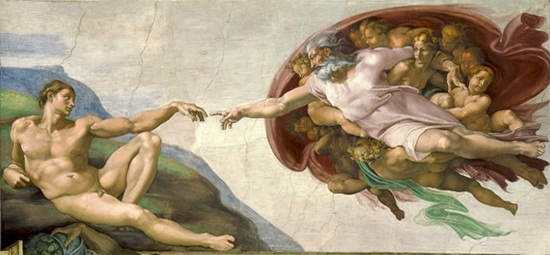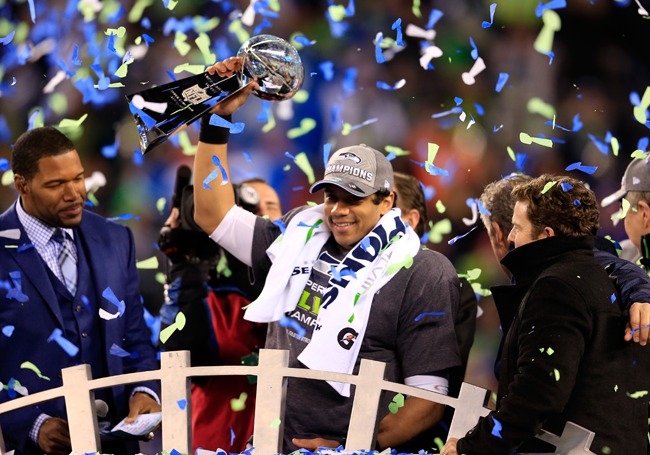This Site Has Moved!
Modern Pensees has moved over to michaelsgraham.com.
Basic wordpress has served this site well for over 5 years but the time has come for it’s own domain, hosting, and better and more responsive theme.
The new RSS feed is here.
You can also subscribe via email by going to the site and entering your email in the top right of the page.
Evangelicals: Now is Not the Time to Spike the Football
I was as happy as you were that the Supreme Court upheld the closely held corporation, Hobby Lobby’s, right to not provide coverage for the 4 abortifacients in the Affordable Care Act. While in no way do I pretend to understand the field of law, the argumentation that closely held corporations appear, function, and act more like individuals than they do corporations made common sense to me – and hence, applying the Constitutional right to dissent to the mandatory coverage of the 4 abortifacients in Affordable Care Act seemed appropriate.
All of that said, now is not the time to spike the football. Evangelicals cannot rely on the Supreme Court, Congress, the Senate, nor the Executive branches to make America a “Christian nation” once again. I am pretty confident that I love America as much as you do, but the reality is that we are a post-Christian nation that is growing increasingly undiscerning. The people/culture(s) of America lack the worldview needed to understand the logical consequences of the breakdown of gender, marriage, and the family (the most fundamental unit of society). The people/culture(s) of America have created a Swiss cheese patchwork quilt from a variety of different worldviews to piecemeal together sets of ideas that justify their behaviors, lifestyles, sin patterns, and addictions.
In other words, we cannot rely on the federal government to be a positive agent of cultural change in America. Cultural change happens at a wide variety of levels but politicians and bureaucrats are chameleons which change their skin color based on the popular opinion – this is why politics is more of a reflection of the culture(s) rather than the driver of the culture(s). Evangelicals have a Herculean task ahead of them to engage the drifting, aimless, and anesthetized conglomeration of sub-cultures that comprise this thing we call the United States of America.
Culture flows out of people’s wants and desires. People’s wants and desires flow out of their hearts. If you want cultural change then you have to see changed hearts. If you want changed hearts then you must see the Holy Spirit remove the heart of stone and replace it with the heart of flesh. If you want the Spirit to move then you must pray for Him to move and you must be faithful to share the Gospel winsomely, clearly, and boldly. I am not saying don’t vote, or don’t engage politically; however, we cannot lobby or legislate people into the Kingdom of God.
Diagnosis, Prescription, Smokescreens, and the Gospel
I’ve never been to a doctor who has given me a prescription without first taking my vital signs, asking pertinent questions, and then given a specific diagnosis. I think sometimes we do prescribe the Gospel before we give a more specific diagnosis in our evangelistic efforts and Gospel conversations.
Gospel Dumptrucks and Hand Grenades
When I was a non-believer I had a few conversations where I certainly felt like the person sharing Jesus with me just wanted me to shut up so they could back their Gospel dump truck on me and verbally unload. Maybe this has been you before – I know I have been on the giving and receiving ends of these conversations. How do we weave the Gospel into our conversations such that we aren’t backing up the dumptruck or lobbing a Gospel hand grenade and running? How can we speak more to the root of the unbelief and less in generalities and/or avoid tangential topics.
Smokescreens and Scuba-Diving
Reformed circles are relatively clear with regards to the essentials of the general Gospel prescription (creation, fall, redemption, consummation). What seems to be unclear is a road-map of how we get to those conversations and how we do winsomely.
The big thing that seems to be missing in all of our evangelistic and/or apologetic dialogue is basic listening and counseling skills. From my perspective most objections to the Gospel fit very broadly into one of three categories: head, heart, or hands. Of the head (intellectual objections), heart (emotive and idol-based objections), and hands (experiential or hypocritical objections) types of objections to the Gospel – so much of our conversations get stuck in head (ie. problem of evil, NT reliability, existence of God…) or hand (ie. ‘Christians are hypocrites’ [duh!], ‘I had a bad experience’, or ‘look at the Crusades’…) type objections to the Gospel. From my experience most of these objections are mere smokescreens meant to derail or parry the conversation away from the idols of their own heart – the real source of their unbelief. For people who have honest (head or hand) questions/objections give them, “honest answers,” as Francis Schaeffer said. To be helpful in our dialogue we must ask questions that get to the heart of the unbelief.
Scuba-diving is the term we use at our church for the art of asking questions that get to the heart and more root level idols. Here are some helpful scuba-diving questions:
-What are you looking forward to?
-What does that do (the potential surface or root level idol) for you?
-If you didn’t have to work (be a mom, study…) what would you most rather be doing?
These are all variations on the basic question, “what do you want?” The answer to the “what do you want” question can sometimes be helpful in diagnosing at least surface level idols (sex, money, laziness). Sometimes you will be able to connect the dots to more root level idols like comfort, escape, power, and control. Sometimes you hit brick walls because you lack the rapport or relationship needed to ask some of these questions. There is an art to scuba-diving where you must re-pressurize every so many feet that you dive and you have to know yourself and your relationship well enough to know how deep you can safely dive.
At the core you are trying to get a better picture of what is more beautiful, compelling, or joyful to them than the Gospel? What is it that they spend their time, money, and thought-life on? What do they want? What the heart wants reveals what the heart worships. The Gospel has so many metaphors, summaries, themes, aspects, touchpoints, and facets. Different Gospel analogies, themes, or metaphors (truth, security, fidelity, fear, anxiety, addiction, adoption, justice, grace, suffering, power, freedom…) can speak more winsomely to different idols. When we take a genuine interest in the other person’s soul we are more prone to ask questions and listen. Questions increase the depth of the scuba-dive. When we see with more specificity what the lost person’s heart wants, then we can speak the Gospel more directly to the idol(s).
Affirmation and Deconstruction
Once we have taken a look at the wants/idols of the person we have something like a diagnosis. Typically, idols are disproportionate manifestations of good things – for example the control idol is the good thing, leadership, absolutized. Before challenging an idol with the sledgehammer of the Gospel consider affirming the elements of it that were once good. Paul did this in Athens in Acts 17:22-23
So Paul, standing in the midst of the Areopagus, said: “Men of Athens, I perceive that in every way you are very religious. For as I passed along and observed the objects of your worship, I found also an altar with this inscription, ‘To the unknown god.’ What therefore you worship as unknown, this I proclaim to you.
The folks in Athens worshiped the idol of new knowledge. Paul stroked the idol before he deconstructed the idol. Earlier in the passage Paul gets chased out of Thessalonica and Berea and heads down to Athens to wait for Silas and Timothy. While Paul is waiting he goes into diagnosis mode in verse 16:
Now while Paul was waiting for them at Athens, his spirit was provoked within him as he saw that the city was full of idols.
Paul diagnosed the idols of the city before speaking the Gospel at them. On a more corporate level, this allowed Paul to affirm the Athenians desire for knowledge before he challenged the inadequacy of their gods. How ineffectual does your pantheon of other gods have to be to have an unnamed god that covers up the weakness and inability of all the others?
One might argue that the Gospel itself already has a diagnosis in it and you would be correct. All have sinned and have fallen short of the glory of God. The kind of diagnosis I have in view here is more specific than it is general. The common state of mankind is helpful to draw out in Gospel conversation and is a necessary component of the Gospel. What I have in view here is connecting the Gospel with more specificity to the idols of the heart. Every idol has a short-run payoff but ultimately all idols over-promise and under-deliver. Good diagnosis allows us to show how the idol will not satisfy in the long-run and show how the Gospel will.
When diagnosis precedes prescription it helps to bring more precise focus and clarity as to how Christ is better than their surrogate god(s). May Paul’s prayer for clarity be the same as ours:
At the same time, pray also for us, that God may open to us a door for the word, to declare the mystery of Christ, on account of which I am in prison— that I may make it clear, which is how I ought to speak. – Col. 4:3-4
What Racism, Human Trafficking, and Abortion All Have in Common
Racism, human trafficking, and abortion all share a common source to their evil – the fundamental denial of human dignity – more specifically the creator endowed dignity of being made in the image of God. This is unilaterally accomplished by carving out groups of people (by ethnicity, gender, vulnerability, or age) who are classified as sub-human and therefore not treated as equal human beings.
Racism
Racism denies the image of God in a particular ethnicity, people group, or tribal affiliation. It seeks to make the persons of such groups or affiliations lesser than your group or affiliation. In doing so it assails the inherent worth endowed by God. There are several idols at work in racism – power, control, pride, and ironically likely both self-love and self-hatred.
Human Trafficking
Human trafficking denies the image of God in humanity by treating certain humans as not being human at all, but rather property. All sense of dignity and worth must be deconstructed in order to justify the human as property. There are several idols at work in human trafficking, most notably, greed, power, control, and lust.
Abortion
Abortion denies the image of God in those of a certain size, age, gestation, or relative level of “wantedness.” The human is made to be sub-human because it is small, young, not yet viable, and has not travelled the magical 6″ journey down the birth canal that suddenly and mysteriously imbues it with life, human rights, and legal status. Their are several idols at work here, most notably, lust, selfishness, comfort, and escape.
While perhaps difficult to personally engage heavily on all three fronts, I find it ironic that my own age demographic seem inclined to care about the first 2 of these 3 and not the third. I don’t know if this is for reasons of ignorance, idolatry, apathy, or all of the above. It will be interesting how history plays itself out on this particular issue… but I am willing to wager that our grand children will think of abortion with a similar disdain that our generation holds toward the Holocaust.
The Banality of Evil and Our Cultural Morass
I hope we would see ourselves as being more dignified than to cut up our children for the pursuit of the ideal body, the next ladder rung of the career, or the perfect orgasm. I hope we would see ourselves as being more dignified than to allow persons to be treated as property for sex or for unpaid work for the pursuit of cheaper goods, uncommitted and intimacy-less sex (rape). I hope we would see ourselves as being more dignified than to allow other ethnicities to be treated as less worthwhile, less valuable, and sub-human for the pursuit of feeling good about one’s own tribe at the expense of another tribe.
There is a certain banality to evil that lulls us into going along and getting along. It was the same banality that anesthetized the very bright German people into the wholesale slaughter of persons categorized as sub-human.
What we want is what we worship and what we worship controls us. This is true if we are pagans, atheists, agnostics, or Christians. We are all slaves to our wants. Those wants drive our ideas… And ideas have consequences… Often dire ones.
What the heart loves, the will chooses, the mind justifies – Thomas Cranmer
An Attempt at How Cultural Orthodoxies (Dogmas) Form
I’ve been pretty surprised at the rate at which new cultural orthodoxies have been formed over the course of my lifetime but particularly the last decade. This post serves as an attempt at dissecting how cultural orthodoxies form and serves to appreciate the complexity of their genesis. There is too much reductionistic thought out there about how cultural shifts occur and most of it centers on just one or two cultural factors and fails to take into account the massive web of multiple reciprocities that is this thing we call culture. Most of the current cultural commentary picks two or three sources as the root causes. Typically the cited sources are institutional – the (liberal) media, corporations, the current political milieu, or highly organized elite power brokers. I think these things have certainly played a role, even key roles, into the cultural shifts that we have seen. That said, I think these views are pretty reductionistic and fail to understand the complexities the constitute culture. As Justin Holcomb has said, “The most powerful aspect of culture is that which we do not think or reason about.” My main point in this piece is that the forces, elements, and ingredients that cause cultural change are very complicated and cannot be boiled down to just a few people, tribes, or institutions.
First, we need to understand what elements of culture are at work, both conscious and unconscious:
There is a constellation of at least 8 things that add to the formulation of cultural dogma – NOTE: 5 of these 8 are directly taken from a presentation delivered by Justin Holcomb and represent heavily thoughts from UVA’s department of Sociology (particularly that of James Davison Hunter) and also that of Christian Smith (Notre Dame)).
1. Artifacts: iPhones, iPads, or other iDevices that unconsciously reorder how we interact with stimuli or information. Artifacts can also be cultural icons such as the Cowboy, Bald Eagle, or Coca-Cola. Artifacts unconsciously impact how we think and interact about our world.
2. Language: Language is the carrier of culture… this is why terminology, accents, vocabularies, technical terms, pronunciations, and word meanings can very heavily geographically even within the same linguistic system. The use of the various aspects of language heavily determines tribal identity.
3. Beliefs, Symbols, or Ideas: these comprise some of the commonly held notions, brand identities, or thoughts of a people group or tribal faction.
4. Social Forces (aka Deep Structures) – Note the first 6 are from Justin Holcomb:
- Individualism
- The Therapeutic – the making of everything as not anyone’s own ultimate responsibility and the centrality of personal happiness of the goal of the individual
- Consumerism – the commodification of things that should not be commodified
- Pluralism – the acceptance of mutually exclusive systems of thought as being equally valued and/or true
- Secularism – the intentional lessening of religious authority in a culture
- Technology
- Democritization of knowledge – consensus is king and if the consensus doesn’t agree with you, bludgeon them until they do
- Post-Modern-Pragmatism – this is my own personal soap box on the mis-labeling of all things post-modern and what we really mean when we say the term “post-modernism”
- Globalism/Mobility – this also relates closely to the rapid rise of urbanization, the velocity of ideas, the fluidity with which people change geographic location, and the role of the worldwide marketplace and supply chain
5. Institutions: politics, education, economic, spiritual, media… etc.
6. Practices or Rituals: these are the conscious (places of worship) or unconscious (shopping, sports, entertainment) liturgies of a culture – more on that here, and here.
7. Elites: these can be media, political, athletic, celebrity, or other cultural curators and definers. One could categorize these as being the heads of various institutions (#5 above), but elites are more individuals than groups and seem to transcend even the institutions that gave them their platforms.
8. The Marketplace: dollars (or perceived dollars) can be the most significant voters of cultural change and this can happen on both the macro (Mozilla) and micro levels (Worldvision).
Second, we need to understand what some of our cultural orthodoxies (dogmas) happen to be:
(Note – I have in view here principally the West and specifically the American cultural context)
-“The highest moral good lay[s] in personal self-fulfillment” – see George Marsden’s book, The Twilight of the American Enlightenment: the 1950s and the Crisis of Liberal Belief – WSJ review here
-Public conversation (or dialogue or discourse) is only to be about facts and not beliefs – in other words it is taboo to talk about God
-Marriage is fundamentally about (romantic) love
-Homosexual behavior is to be accepted at least as non-abnormal and in some instances as normative
-What doesn’t hurt other people is morally permissible
–Authenticity to self and personal happiness are very important virtues and perhaps the highest of all the virtues
-Personal happiness is ultimate
-Sex is principally intended for pleasure
-Be good (in your own eyes) in order to be self-actualized (happy)
-The subjective individual self, in combination with the herd (read: democritization of knowledge), is the greatest interpreter, curator, and judge of what is true, good, and beautiful (over against history, data, or external authority)
Third, we need to understand the interplay of the cultural elements with the culture, our tribal faction, and ourselves
Velocity of ideas:
Before movable typeset, ideas and culture were principally only shared along trade routes. Those trade routes which were often roads or nautical routes were the only means by which one culture (or tribe) might cross-polinate another group. This made the velocity of ideas was much slower than in post-industrial and pre-internet age. Another complexity to the transmission of ideas dealt with low levels of literacy and significant linguistic barriers that existed for millennia. Oral traditions can travel remarkably quick yet must gain certain thresholds of cultural penetration in order to take route and multiple through generations. The paradigm shifts in the transmission of ideas were principally the Gutenberg printing press, transportation advances (cars, planes… etc.), and communication revolutions (radio, television, satellite, internet, web 2.0). These paradigm shifts in transmission of ideas has radically increased the velocity of ideas. In the modern era, ideas can travel at nearly limitless speed, spread through thousands of seemingly disparate and unconnected networks or tribes, and reach saturation levels significant enough to change public opinion, shape political policy, or even to overthrow governments (ie. Twitter and the Arab Spring).
Cultural Interaction is Determinative of Belief:
Humans naturally gravitate toward like kind and like minded. That said, there is significant interplay between what we believe and how you come up with what you believe. Orthodoxy (right beliefs) affects orthopathos, (right emotions) affects orthopraxis (right practice), affect orthodoxy, affects orthopraxis, affects orthodoxy… ad infinitum. So how we interact with culture – whether we engage it, critique it, or embrace it will impact consciously or unconsciously what we believe. You can evidence this very clearly with radically undercontextualized and/or cultish groups like the FLDS or the Westboro Baptist folks.
Unconscious Cultural Elements:
The seven cultural elements listed above are constantly influencing our lives in good ways, bad ways, and every shade of grey in-between. Most of this influence is unconscious, subconscious, selectively ignored, or down played as not playing a role in what we believe. I have had several hundred conversations with people about what they believe. In an overwhelming number of such instances, people believe the set of ideas that justify their wants, desires, and passions. In these instances the horse was the wants, desires, and passions of the heart that drove the cart of the justifications, rationalizations, and knowledge of the head. In other words, people seek evidence, truth, arguments, facts, and knowledge about their beliefs after those beliefs are formed by their belief system (secular, religious, philosophical, or other). There are notable exceptions, but this seems to be more normative than not. Most folks could not even name a single thinker, writer, philosopher, sacred text, or cultural element that was the genesis of their most central tenets, dogmas, orthodoxies, or beliefs.
Conscious Elements:
That said, some of these cultural elements above are very conscious. These elements are the ones that tend to get the most ink spilled about them. It is usually institutions and elites that get the most attention and the usual scapegoats for when their is some rising cultural dogma that is contrary to our own tribal orthodoxy. I do not wish to downplay the role of celebrity, elites, the marketplace, and institutions of all kinds in the formulation of new cultural dogmas. The role of these conscious elements has been well noted in the sexual revolution, the rise of feminism, the rise of fundamentalism and evangelicalism, and have shaped the battle lines on other issues like abortion, gender, and sexuality.
Concluding thoughts: If you have bought into the idea that the contours of the cultural landscape are complex and inter-related, then I hope that you might be willing to think and interact on those contours with more deftness and in a manner than is more winsome. I would hope that you would be able to identify more readily some of unconscious elements that comprise the invisible hand of culture. Be patient with people who do not understand or do not care that they hold numerous mutually exclusive ideas in their worldview. Have compassion on the culture for it is harassed and helpless:
When he saw the crowds, he had compassion for them, because they were harassed and helpless, like sheep without a shepherd. Matthew 9:36
For further reading:
Culture Wars, James Davison Hunter
Intellectuals, Paul Johnson
Total Truth, Nancy Pearcey
The Twilight of the American Enlightenment: the 1950s and the Crisis of Liberal Belief, George Marsden
Social and Cultural Dynamics, Pitirim Sorokin
To Change the World, James Davison Hunter
Desiring the Kingdom, James K. A. Smith
One Day in the Life of Ivan Denisovich, Alexander Solzhenitsyn
Doctrine of the Knowledge of God, John Frame
Secular Worship Services, Part One: The Grammys
The longer I live the more convinced I become that all of life is worship. The only thing that changes is the object or subject of our affection. With such a view in mind, you begin to see liturgies emerge in common cultural forms. Liturgy is just a fancy theological term for a customary worship service. This post is the first of a series of posts examining several common secular worship services in America. Later posts will examine the Superbowl, the Oscars, Disney, and college football.
I caught the lion share of the 2014 Grammy’s after the fact, hence the tardiness of this post. I’ve never been super big on all the hype, pomp, and patting on the back – not to mention the huge amounts of filler, commercials, and non-musical content. What was particularly interesting was the sharp focus of the Grammy liturgy. The whole show was bizarre, raunchy, and exactly what you would expect as a liturgy of the secular decline of the West. Pop culture in particular has embodied the descent of Western civilization back into a season of sensate culture. The liturgy roughly follows something of Western Christian worship service:
Welcome
LL Cool J rehashes more or less the same speech he gave last year about how music unites humanity.
Call to Worship
Beyonce – Drunk in Love. Visuals are inappropriate for print here. Suffice to say that it is an ode to drunken fornication. Beyonce’s visuals matched the raunch of the lyrical content. More of the same Cold War sexual arms race for Western attention.
Worship in Song
Katy Perry – Dark Horse. This performance was equal parts Illuminati (cue the conspiracy theorists) and witchcraft. It featured more of the same attempts to distance herself from her evangelical upbringing by summoning disparate and cliche ridden neo-pagan mixed metaphors.
Sermon/Homily/Sacrament
Macklemore, Ryan Lewis, and Madonna – Same Love. The sermon came from Queen Latifah. The concert hall is visually transformed into something like a cathedral and a kind of wedding ceremony ensues. We are invited to take part in the sacrament of the 33 heterosexual and homosexual couples as they exchange their wedding vows. You can watch it here:
Benediction
Nine Inch Nails – Copy of a. This final performance was drenched with irony from Trent Reznor. The lyrics heavily resound with a scathing critique of our sensate culture and reverberate with echoes of Ecclesiastes:
I am just a copy of a copy of a copy
Everything I say has come before
Assembled into something into something into something I am never certain anymore
I am just a shadow of a shadow of a shadow
Always trying to catch up with myself
I am just an echo of an echo of an echo
Listening to someone’s cry for help
There is nothing new under the sun…
Check back for the next in the series.
Best Links of the Week
Great fake travel posters made by artist Ali Xenos. There are some great ones of Rivendell, Tatooine, Dagobah, and Winterfell.
Kevin DeYoung on the New-Calvinism
‘Gravity’ Spinoff: Watch the Other Side of Sandra Bullock’s Distress Call – Jonas Cuaron’s seven-minute companion short, filmed in Greenland and featuring Bullock’s voice
Brutal personal piece on about one young man’s battle with our present culture of death – “I Lost My Daughter to the Culture of Death”
Modalimy – Co-parenting for those that want children but not a relationship or marriage. You really cannot make this stuff up.
“Nelson Mandela: A Candid Assessment” – from Catholic site Crisis Magazine
Interesting piece from personal finance blog Mr. Money Mustache entitled, “Get Rich With: The Position of Strength.” Makes some salient points.
Woofmaker.com – just click on it, especially if you are a Home Alone fan.
Interesting piece in the Atlantic dealing with Clickbait and UpWorthy’s game changing headlines












